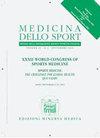不同比例的血流限制对全力后蹲运动的急性影响
IF 0.6
4区 医学
Q3 MEDICINE, GENERAL & INTERNAL
引用次数: 0
摘要
背景:本研究旨在分析不同动脉闭塞压(AOP)百分比的血流量限制(BFR)训练联合深蹲运动(SQ)对急性运动的影响。方法:纳入男性志愿者17例(24.94±5.64岁)。参与者进行了适应训练和一次最大重复(1-RM)测试。参与者被随机分为三组:仅进行无血流限制的阻力训练(RT) (BFR 0%)和两个不同的AOP组,BFR(80%和150%)应用于下肢;各组分别命名为BFR0、BFR80和BFR150。在所有的练习中,SQ都被应用于背部半深蹲。通过重复次数、平均功率和峰值功率、平均速度和峰值速度以及感知用力率(REP)来评估运动对力量和耐力表现的急性影响。结果:三组患者在重复次数、平均功率、平均速度、REP得分均以BFR0-150最高(P≤0.05)。BFR80和BFR150组的重复次数、平均功率和平均速度显著高于BFR0组(P<0.05)。与BFR150和BFR0组相比,BFR80组的REP显著降低(P<0.05)。结论:以BFR150进行全强度后蹲运动的急性运动效果最好。这表明,在相同负荷和功率输出的情况下,与传统力量训练相比,BFR训练可以为训练者和运动员提供更多的重复次数。本文章由计算机程序翻译,如有差异,请以英文原文为准。
The acute effects of different percentages of blood flow restrictions on all-out back squat exercise
BACKGROUND: This study aimed to analyze the effects of different arterial occlusion pressure (AOP) percentages of blood flow restriction (BFR) training combined with squat exercise (SQ) on acute exercise.METHODS: Seventeen male volunteers (24.94±5.64 years) were included in the study. Participants underwent adaptation sessions and a one-repetition maximum (1-RM) test. Participants were randomly assigned to three groups: resistance training (RT) only without blood flow restriction (BFR 0%) and two different AOP groups with BFR (80% and 150%) applied to the lower limb; the groups were termed BFR0, BFR80, and BFR150, respectively. SQ was applied as a back semi-squat in all exercise sets. The acute effects of the exercise on strength and endurance performance were evaluated by repetition number, mean and peak power, mean and peak velocity, and rate of perceived exertion (REP).RESULTS: BFR0-150 had the highest scores in terms of repetition number, mean power, mean velocity, and REP among all three groups (P≤0.05). The number of repetitions, mean power, and mean velocity were significantly higher in the BFR80 and BFR150 groups than in the BFR0 group (P<0.05). However, REP was significantly lower in BFR80 compared to the BFR150 and BFR0 groups (P<0.05).CONCLUSIONS: Performing back squat all-out exercise with BFR150 resulted in the best acute exercise effects. This suggests that BFR training can provide trainers and athletes with more benefits in performing sports programs in terms of the number of repetitions with the same loads and power outputs as traditional strength training.
求助全文
通过发布文献求助,成功后即可免费获取论文全文。
去求助
来源期刊

Medicina Dello Sport
医学-医学:内科
CiteScore
1.10
自引率
50.00%
发文量
55
审稿时长
>12 weeks
期刊介绍:
The journal Medicina dello Sport, official journal of the Italian Federation of Sports Medicine (FMSI), is an external peer-reviewed scientific journal, publishes scientific papers on sports medicine.
 求助内容:
求助内容: 应助结果提醒方式:
应助结果提醒方式:


